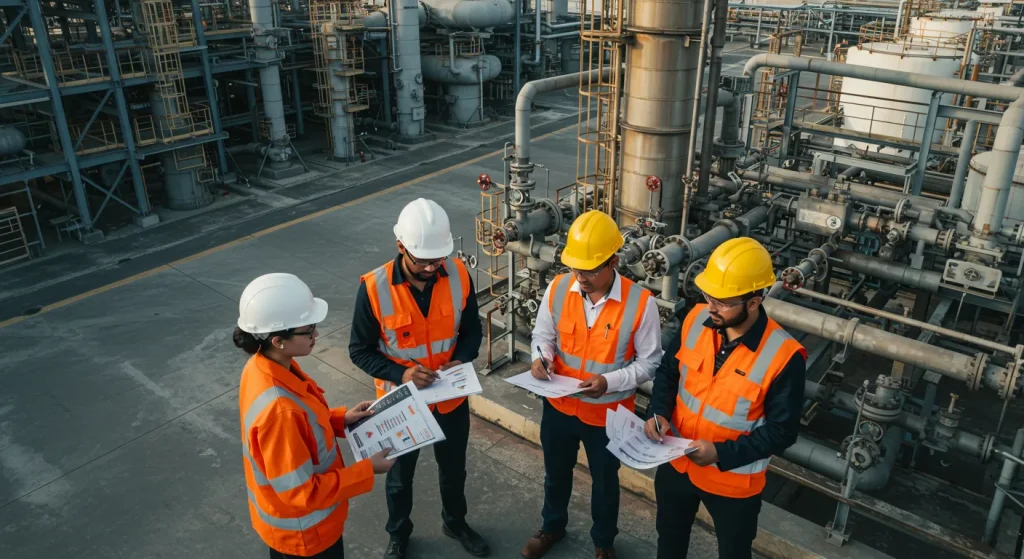
## Oil and Gas Early Production Facilities: A Fast Track to Revenue
In the dynamic landscape of oil and gas exploration and production, speed to market is paramount. This is where Early Production Facilities (EPFs) come into play, offering a strategic advantage for companies looking to generate revenue quickly while evaluating the long-term potential of a field.
**What are Early Production Facilities?**
An EPF is a temporary or semi-permanent processing facility designed to bring oil and gas wells into production rapidly. Unlike permanent, large-scale processing plants, EPFs are typically smaller, modular, and more easily deployed. They are designed to handle initial production volumes, allowing operators to:
* **Generate early revenue:** Start selling produced oil and gas sooner, offsetting exploration and development costs.
* **Gather crucial reservoir data:** Gain valuable insights into reservoir characteristics, well performance, and fluid properties under actual production conditions.
* **De-risk larger investments:** Determine the economic viability and long-term potential of a field before committing to a full-scale development project.
* **Optimize future development:** Use the data obtained from the EPF to design and optimize the permanent production facilities, ensuring efficient and cost-effective operations.
* **Reduce flaring:** While primarily focused on production, modern EPFs often incorporate technologies to minimize flaring of associated gas.
**Key Components of an EPF:**
An EPF typically includes the following key components:
* **Wellhead:** Where the oil and gas are extracted from the well.
* **Separation Equipment:** Separates the produced fluids (oil, gas, and water) into their individual components.
* **Stabilization Equipment:** Stabilizes the oil and gas to meet pipeline specifications for transportation.
* **Water Treatment:** Removes impurities from produced water for disposal or reinjection.
* **Gas Processing:** Processes the gas to remove impurities like H2S and CO2, and prepares it for transportation or utilization.
* **Storage Tanks:** Store the separated oil, gas, and water before transportation or disposal.
* **Metering and Control Systems:** Measure and control the flow of fluids throughout the facility.
* **Power Generation:** Provides power for the EPF’s operations.
**Advantages of Using EPFs:**
* **Faster Time to First Oil/Gas:** Significantly reduces the time required to bring a field into production compared to traditional development methods.
* **Lower Capital Expenditure (CAPEX):** Requires a smaller initial investment compared to permanent processing facilities.
* **Flexibility and Mobility:** Modular design allows for easy relocation to other fields or integration into permanent facilities.
* **Improved Reservoir Management:** Provides valuable data for optimizing reservoir performance and maximizing recovery.
* **Reduced Environmental Impact:** Modern EPFs are designed with environmental considerations in mind, minimizing emissions and waste.
**Applications of EPFs:**
EPFs are particularly well-suited for:
* **Marginal Fields:** Economically viable option for developing smaller, less productive fields.
* **Offshore Fields:** Allows for early production while permanent platforms are being constructed.
* **Remote Locations:** Can be deployed quickly and efficiently in areas with limited infrastructure.
* **Extended Well Testing (EWT):** Provides a cost-effective way to test the long-term performance of wells.
* **Pilot Projects:** Validates the feasibility of new production technologies.
**Challenges and Considerations:**
* **Permitting and Regulatory Compliance:** Obtaining necessary permits and complying with environmental regulations can be time-consuming.
* **Logistics and Transportation:** Transporting and installing the EPF equipment can be challenging, especially in remote locations.
* **Operational Complexity:** Requires skilled personnel to operate and maintain the facility.
* **Limited Capacity:** EPFs are designed for initial production volumes and may need to be upgraded or replaced as production increases.
**The Future of EPFs:**
As technology continues to advance, EPFs are becoming more sophisticated, efficient, and environmentally friendly. Innovations in modular design, automation, and remote monitoring are further enhancing their capabilities and making them an increasingly attractive option for oil and gas operators.
**Conclusion:**
Oil and Gas Early Production Facilities provide a valuable tool for accelerating production, gathering critical reservoir data, and de-risking larger investments. By enabling faster time to first oil/gas and reducing CAPEX, EPFs empower operators to maximize the value of their assets and optimize their development strategies. As the industry continues to seek innovative solutions for efficient and sustainable production, EPFs are poised to play an increasingly important role in the future of oil and gas development.